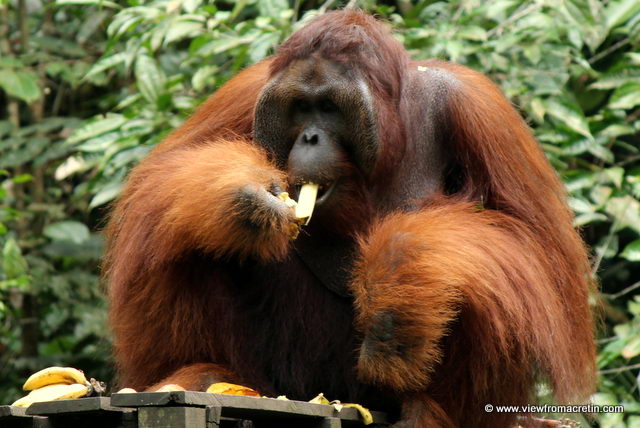Orangutans are the largest arboreal creatures on earth. Currently they live in the rainforests of Sumatra and Borneo. They have classified into two main species: Bornean Orangutan (P. pygmaeus) and Sumatran Orangutan (P. abelii). Of all the great apes they are the most arboreal as they spend almost all the time on trees.
What Do Orangutans Eat
They are highly opportunistic foragers. In comparison to bonobos and gorillas, orangutans do not seem to have too much choice in terms of food or diet. Since they spend time on trees orangutans rely heavily on fruits including figs (Ficus spp.) and durian (Durio spp.) These fruits are available in patches. Fruits include Antiaris toxicaria (Moraceae), Cyathocalyx sumatranus (Annonaceae), Mallotus schaeorocarpus (Euphorbiaceae), Tinomiscium phytocrenoides, Garcinia spp. Orangutans seem to like smaller fruits.
Orangutans gather around in large number where strangled fig trees are abundant. However not all fig trees are consumed as some species are favored over the others and at Ketambe they feed on F. benjamina, F. stupenda, F. subulata, and F. drupacea, and Ficus annulata.

Sumatran orangutans consume leaves more regularly than other members. Their diet is composed of 5 – 25% of leaves. They eat the leaves of stinging nettles such as Dendrocnide spp. (Urticaceae). Apart from fruits and leaves, orangutans also rely on aerial roots, leaf galls, epiphytic fungi, grass, orchids, stems of climbers, for their consumption.
They feed on about 17 species of insects. At times they also consume soil.
Orangutans remain active during the day—they spend most of the time in foraging and eating fruits. This explains that the limited amount of food also brings in a competition among apes and also restricts the number of orangutans that forages in any area.
Nonetheless, they do not always consume fruits. Orangutans supplement their diet with leaves, bark, insects, and seeds when the fruit is scarce. Orangutans typically prefer to consume fruits when they are readily available.
Orangutans rarely feed on animal prey such as loris (Loris spp.) precisely because they are not active hunters. They are intelligent animals and when the food is scarce they use tools to extract otherwise unavailable foods. Orangutans are very good at extracting food in that they insert probe tools into tree trunks and take out the larvae, insects, and honey. By doing so, they make up the deficiency of food.
Depends on the season, orangutan’s diet varies significantly. About 65 – 90% of the orangutan’s diet is composed of fruits. Bornean orangutans are known to feed on 317 different food items including honey, bird eggs, and young leaves.
They use probing tools to break the nest inside a tree hole. These nests are located high above the ground which is why orangutans sometimes hold the tool and insert with it their teeth.
Orangutans also use another technique of extracting food. They make a short blunt tool which they use to extract calorie-rich seeds hidden in a spiny (Neesia sp.) fruit. There are spikes on these fruits and their skin is also very hard. Orangutans the side of the fruit and the seeds fall onto the ground. They cannot open the fruit without using tools because there are spines on the skin and the fruit’s interior has irritating fibers. Thanks to this strategy, orangutans are able to enjoy calorie-rich foods which are hardly accessible to other animals.






Leave a Reply